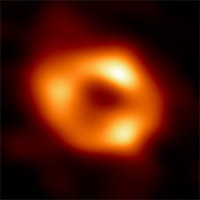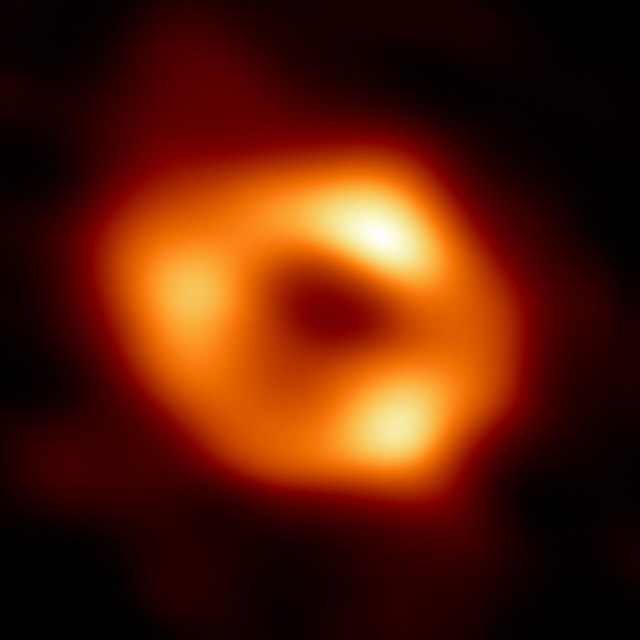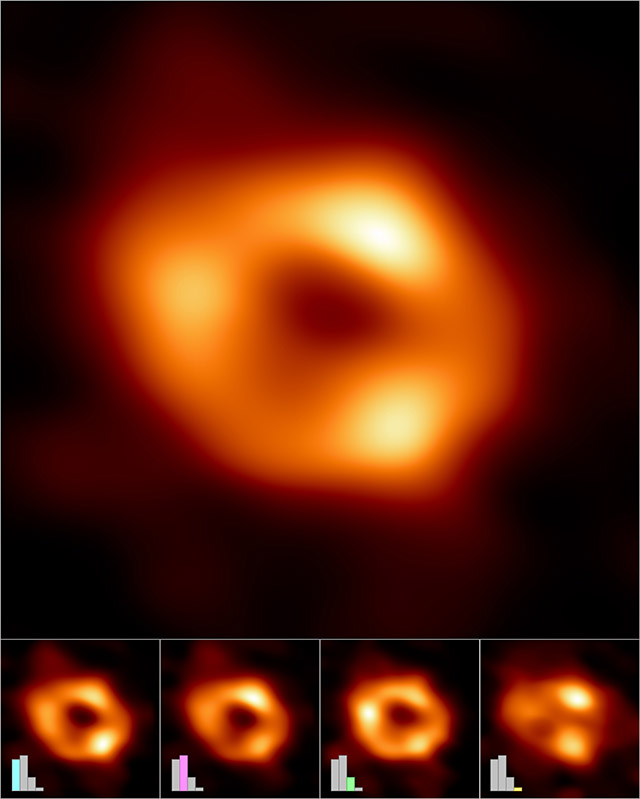Astronomers use the Event Horizon Telescope to capture the first image of the black hole at the center of our galaxy
posted Thursday, May 12, 2022 at 10:30 AM EDT

Astronomers on the Event Horizon Telescope team have revealed the first image of the supermassive black hole at the center of the Milky Way galaxy.
Scientists had previously observed stars orbiting something "invisible, compact, and very massive" at the center of the Milky Way. The evidence suggested that the object, known as Sagittarius A*, also known as Sgr A*, is a black hole. The new image provides the first direct visual evidence that this theory is correct.
The black hole is completely dark, so we can't see it. However, the glowing gas surrounding it reveals "a telltale signature: a dark central region (called a 'shadow') surrounded by a bright ring-like structure." The new image shows the black hole's gravitational force bending the light around it. The black hole is believed to be four million times more massive than our Sun.

"Although we cannot see the event horizon itself, because it cannot emit light, glowing gas orbiting around the black hole reveals a telltale signature: a dark central region (called a 'shadow') surrounded by a bright ring-like structure. The new view captures light bent by the powerful gravity of the black hole, which is four million times more massive than our Sun. The image of the Sgr A* black hole is an average of the different images the EHT Collaboration has extracted from its 2017 observations."
Credit: EHT Collaboration. Click here to see a high-resolution version.
"We were stunned by how well the size of the ring agreed with predictions from Einstein's Theory of General Relativity," said EHT Project Scientist Geoffrey Bower from the Institute of Astronomy and Astrophysics, Academia Sinica, Taipei. "These unprecedented observations have greatly improved our understanding of what happens at the very center of our galaxy, and offer new insights on how these giant black holes interact with their surroundings."
Sgr A* is about 27,000 light-years from Earth and appears to us to be about the same size in the sky as a donut on the moon's surface. To image something so small in the sky requires the Event Horizon Telescope. EHT links eight existing radio observatories across the planet to form a single 'Earth-sized' virtual telescope. EHT observed Sgr A* across multiple nights for many hours, like capturing a long-exposure photograph.
EHT has previously observed the black hole at the center of the distant Messier 87 galaxy known as M87*. The two black holes look similar, but the black hole at the center of the Milky Way is about a thousand times smaller and less massive than M87*. "We have two completely different types of galaxies and two very different black hole masses, but close to the edge of these black holes they look amazingly similar," says Sera Markoff, Co-Chair of the EHT Science Council and a professor of theoretical astrophysics at the University of Amsterdam, the Netherlands. "This tells us that General Relativity governs these objects up close, and any differences we see further away must be due to differences in the material that surrounds the black holes."

"The main image was produced by averaging together thousands of images created using different computational methods — all of which accurately fit the EHT data. This averaged image retains features more commonly seen in the varied images, and suppresses features that appear infrequently."
"The images can also be clustered into four groups based on similar features. An averaged, representative image for each of the four clusters is shown in the bottom row. Three of the clusters show a ring structure but, with differently distributed brightness around the ring. The fourth cluster contains images that also fit the data but do not appear ring-like."
"The bar graphs show the relative number of images belonging to each cluster. Thousands of images fell into each of the first three clusters, while the fourth and smallest cluster contains only hundreds of images. The heights of the bars indicate the relative 'weights,' or contributions, of each cluster to the averaged image at top."
Credit: EHT Collaboration. Click here to see a high-resolution version.
Despite being much closer than M87*, Sgr A* was significantly more difficult to image. "The gas in the vicinity of the black holes moves at the same speed — nearly as fast as light — around both Sgr A* and M87*. But where gas takes days to weeks to orbit the larger M87*, in the much smaller Sgr A* it completes an orbit in mere minutes," explains EHT scientist Chi-kwan 'CK' Chan, from Steward Observatory and Department of Astronomy and the Data Science Institute of the University of Arizona. "This means the brightness and pattern of the gas around Sgr A* was changing rapidly as the EHT Collaboration was observing it — a bit like trying to take a clear picture of a puppy quickly chasing its tail."
Researchers developed new tools to account for the gas movement around Sgr A*. More than 300 researchers from 80 institutes comprise the EHT Collaboration. The monumental image of Sgr A* resulted from five years of hard work and ingenuity. The new image allows scientists to compare two visibly similar black holes of extremely different sizes. The data can help scientists better understand how gas behaves around supermassive black holes. "Now we can study the differences between these two supermassive black holes to gain valuable new clues about how this important process works," said EHT scientist Keiichi Asada from the Institute of Astronomy and Astrophysics, Academia Sinica, Taipei. "We have images for two black holes — one at the large end and one at the small end of supermassive black holes in the Universe — so we can go a lot further in testing how gravity behaves in these extreme environments than ever before."
(Via BBC)